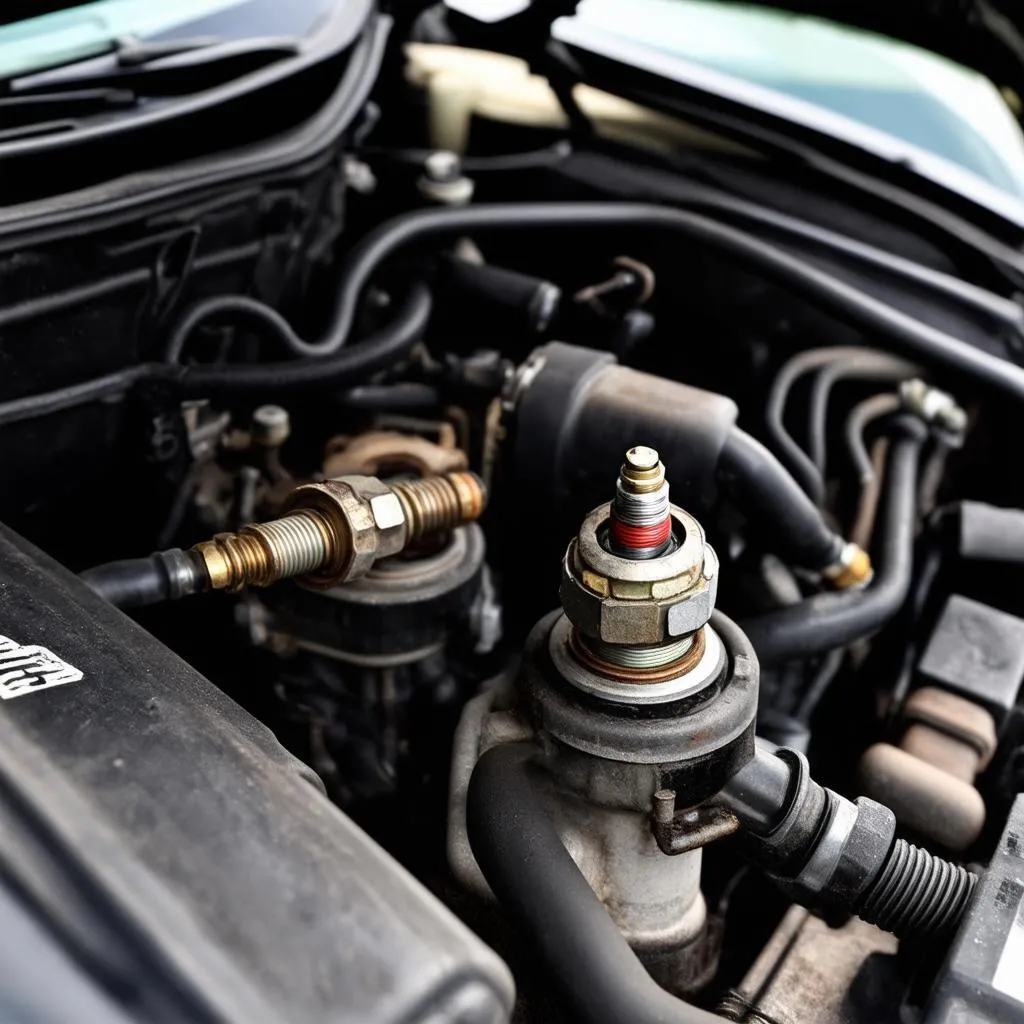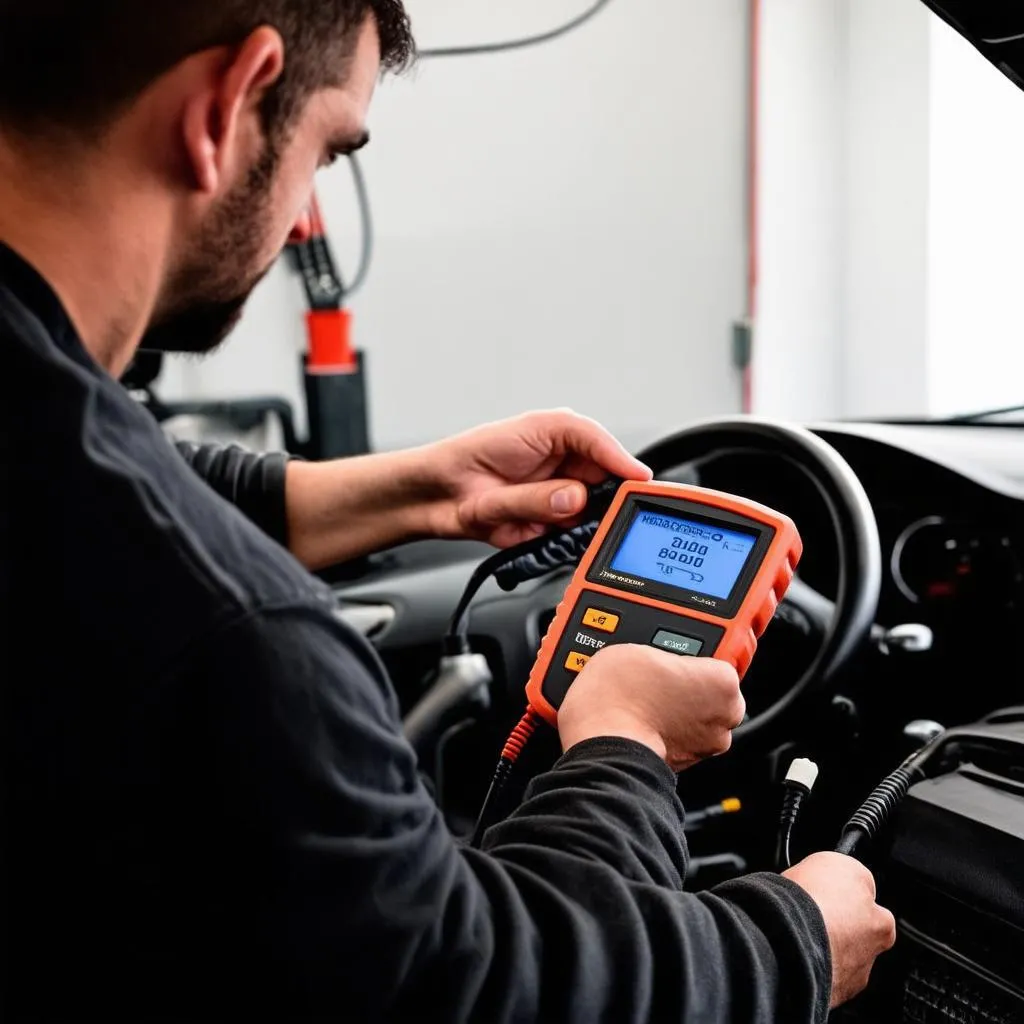Imagine this: you’re cruising down Highway 1, California sun shining, the Pacific Ocean shimmering to your right. Suddenly, your car starts sputtering, the “check engine” light blinks ominously, and your smooth ride turns into a bumpy nightmare. You pull over, whip out your trusty OBD2 scanner, and bam—P0300: Random/Multiple Cylinder Misfire Detected. What now?
Decoding the Mystery of the P0300 Code
Before panic sets in, let’s break down this cryptic code. A P0300 doesn’t necessarily mean your engine is about to explode. It’s a signal from your car’s computer (the ECU) that something’s amiss with the combustion process in one or more cylinders. Basically, the air-fuel mixture isn’t igniting properly, causing the engine to misfire.
From a mechanic’s perspective, a P0300 is like a starting point. “It’s rarely the final diagnosis,” says John Miller, a seasoned mechanic with over 20 years of experience at a BMW dealership in Munich, Germany. “It tells us there’s a problem, but we need to investigate further to pinpoint the culprit.”
Technically speaking, a misfire happens when the spark plug fails to ignite the air-fuel mixture at the precise moment. This disruption can be caused by various factors, making P0300 a notorious headache for car owners and mechanics alike.
Why is My Engine Throwing a P0300 Tantrum?
Several culprits can trigger a P0300 code, ranging from minor annoyances to serious engine issues. Here’s a rundown of the usual suspects:
- Spark Plugs and Wires: Worn-out spark plugs or damaged wires can disrupt the electrical current needed for ignition.
- Ignition Coils: These components provide the high voltage needed for the spark plugs. A failing coil can lead to misfires in specific cylinders.
- Fuel System: Issues like clogged fuel injectors, a faulty fuel pump, or a dirty fuel filter can disrupt the air-fuel mixture, causing misfires.
- Vacuum Leaks: Leaks in the intake manifold or vacuum hoses can disrupt the precise air-fuel ratio needed for proper combustion.
- Sensors Gone Haywire: Malfunctioning sensors, such as the mass airflow sensor (MAF), oxygen sensor (O2), or throttle position sensor (TPS), can send incorrect data to the ECU, leading to misfires.
- Mechanical Problems: In more severe cases, internal engine problems like a burnt valve, a blown head gasket, or low compression can trigger a P0300 code.
Getting to the Root of the Problem: Diagnosing a P0300
Since multiple factors can cause a P0300, pinpointing the root cause requires a systematic approach. Here’s what you can expect at a mechanic’s workshop:
- Visual Inspection: A mechanic will start by visually inspecting the engine bay for any obvious issues, such as damaged spark plug wires or loose vacuum hoses.
- Code Reading and Analysis: Using a professional-grade OBD2 scanner, the mechanic can retrieve more detailed information about the P0300 code, including freeze frame data that captures the engine’s condition at the time of the misfire.
- Component Testing: The mechanic will test individual components such as spark plugs, ignition coils, fuel injectors, and sensors to check their functionality.
- Fuel Pressure and Vacuum Testing: These tests help identify issues with the fuel delivery system and vacuum leaks.
- Compression Test: In cases of suspected internal engine damage, a compression test can reveal problems with piston rings, valves, or the head gasket.
What Happens If I Ignore a P0300?
Ignoring a P0300 code is like ignoring a flashing “danger” sign. While driving with a minor misfire might seem harmless initially, it can lead to:
- Reduced Fuel Economy: Misfires waste fuel, as unburnt fuel gets dumped into the exhaust system.
- Catalytic Converter Damage: The catalytic converter, responsible for reducing harmful emissions, can be damaged by the excess unburnt fuel from misfires.
- Engine Damage: Prolonged misfires can cause damage to pistons, valves, and other internal engine components, leading to costly repairs.
Preventing Future Misfire Mayhem:
While you can’t always prevent car troubles, following a regular maintenance schedule can significantly reduce the chances of encountering a P0300 code:
- Spark Plug and Wire Replacement: Follow your car manufacturer’s recommended service intervals for spark plug and wire replacement.
- Fuel System Cleaning: Regularly cleaning the fuel injectors and using a quality fuel system cleaner can prevent clogs and ensure optimal fuel delivery.
- Air Filter Replacement: A clean air filter ensures the engine receives an adequate supply of clean air, crucial for proper combustion.
- Regular Inspections: Schedule routine inspections by a qualified mechanic to catch potential issues early.
 Car Engine Misfire Spark Plugs
Car Engine Misfire Spark Plugs
FAQs About OBD Code P0300:
Q: Can I drive my car with a P0300 code?
A: While you might be able to drive short distances, it’s not recommended. Driving with a misfire can cause further damage to your engine and catalytic converter.
Q: How much does it cost to fix a P0300 code?
A: The repair cost varies widely depending on the underlying cause. Simple fixes like spark plug replacement can cost under $100, while more serious repairs like a head gasket replacement can cost thousands of dollars.
Q: Can a bad oxygen sensor cause a P0300 code?
A: Yes, a faulty oxygen sensor can disrupt the air-fuel mixture, potentially leading to a P0300 code.
 Mechanic Diagnosing P0300 Code
Mechanic Diagnosing P0300 Code
Need More Help with Car Diagnostics?
Don’t let car troubles spoil your journey. If you’re struggling with a P0300 code or any other automotive mysteries, our team of expert mechanics is here to help.
Contact us on WhatsApp at +84767531508 for 24/7 support and expert advice on diagnostic tools and car repair.
Explore More Car Diagnostic Insights:
- OBD Code P0420: Catalytic Converter Efficiency Below Threshold
- Understanding Your Car’s Electrical System
- Common Car Sensor Problems and Solutions